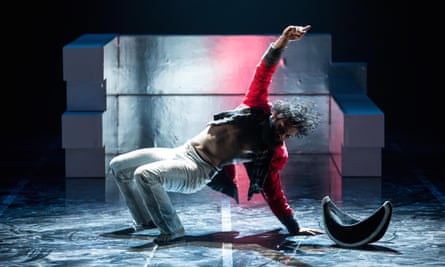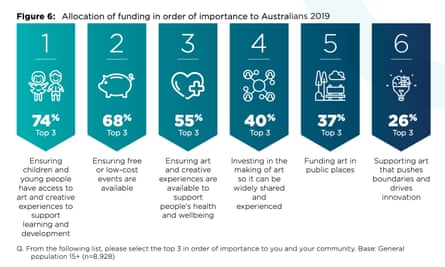Extract from The Guardian
Australian arts in focusCulture

Appreciation for the creative arts is on the rise as the industry languishes, according to a landmark report which Australia Council calls a ‘portrait of what we stand to lose’
Last modified on Wed 26 Aug 2020 09.56 AEST
New survey data from the Australia Council highlights the vital and growing role played by the arts and culture in the lives of Australians, as the industries themselves face more challenges than ever.
The latest edition of the National Arts Participation Survey, released on Wednesday and following on from reports in 2009, 2013 and 2016, canvassed a representative sample of 8,928 Australians about their views about and participation in arts and culture.
The top-level statistics are impressive: few other industries can boast sustained engagement with 98% of the population. The survey shows a significant rise in both the number of Australians who believe in the positive impacts of the arts, and the number who support it being publicly funded.
It
finds 23 out of every 25 Australians listened to recorded music in
2019, a third of them daily; and 82% of Australians engaged with the
arts online, the majority through streaming music. We’re also keen
readers, with 72% of us reading for pleasure; nearly half of all
Australians read a novel in 2019.
Perhaps most impressively, all the key metrics are increasing – or at least were increasing, before Covid-19 struck. The performing arts were a standout: two-thirds of Australians attended live performances in 2019, with each art form growing their audiences.
Live music was up from 43% in 2016 to 48% last year. Live theatre attendance was up from 30% in 2016 to 37%. Gallery visits were up from 33% to 37%, dance attendance was up from 24% to 29% and attendance at writers’ festivals and literary events up from 15% to 22%.
We’re creating art in our own lives too. The survey says more than 9 million Australians regularly make or collaborate in the making of art. Some of the participation figures are startling. It’s perhaps not surprising that nearly 5 million Australians paint, draw or create visual art, and 3 million play music. But who knew that one in six Australians participated in community art, or that 2.8 million identify as creative writers? As with the data on attendance, the figures for creative participation are also on the rise.
The survey data is crucial information at a time of crisis in the cultural sector. The coronavirus pandemic has led to the near total shutdown of the live performance sector, and led to crippling job losses in arts and cultural employment. Although the federal government and the states and territories have announced emergency funding packages, 15% of payroll jobs in arts and recreation have been lost since March, and the Morrison government’s $250m rescue fund is still months away from delivery.
Art has benefits for mental health, education and connection
Drill further into the Australia Council study, and fascinating insights are revealed. Australians seem overwhelmingly convinced of the value of the arts and culture, with 84% of those surveying agreeing on the positive impacts of culture – up from 75% in 2016. Two-thirds of those responding said art and creativity helps children develop, 56% said it had positive impacts on our sense of wellbeing and happiness, and the same percentage thought it helped to deal with stress, anxiety or depression.
At a time when Australia faces intensifying mental health challenges, this study is further evidence that the arts and culture has a policy role to play beyond the subordinate portfolio in a junior ministry where it currently languishes.

Australians’ appreciation of arts and culture was reflected in other responses. Big and increasing majorities of respondents agreed that artists should have freedom of expression (76%, up 15 points from 2016); that the arts should be an important part of education (73%, up 12); and that the arts allow us to connect with others (53%, up 15).
Significantly, support for public funding of the arts was at 63%, up 12 percentage points from 2016.
When the survey looked at specific groups in our society, the value of culture was even more evident. Younger Australians, First Nations respondents, and Australians from culturally and linguistically diverse backgrounds all showed passionate levels of engagement well above those of the general population. Eight-three per cent of younger Australians attended arts events in 2019, and for regional and remote First Nations respondents, that figure increased to an astonishing 91%. Creative participation for First Nations groups was higher across nearly every dimension.
While the blizzard of statistics will delight the data nerds, the study also asked more nuanced and qualitative questions about the role and value of culture in Australian society.
Research firm Patternmakers’ Tandi Palmer Williams conducted some of the focus groups that fed into the National Arts Participation Survey.
She told Guardian Australia that one of the key takeaways of the focus groups was “a fairly widespread understanding” of the benefits of art and culture – but one that wasn’t necessarily matched by an understanding of how arts and creativity are funded.
“Most people could appreciate the integral value of the arts in the lives of children in their education, or in bringing communities together in social cohesion,” Palmer Williams said. “But when we talked about the role of governments in supporting that, there were mixed views.” She suggests that one motivation for this disconnect may be a general distrust of politicians delivering cultural funding fairly.
All in all, the National Arts Participation Survey paints a portrait of Australian culture as an immensely vibrant and fertile sphere of our society. While the performing arts are struggling to recover from the devastation of Covid-19, the survey shows that for most Australians before the pandemic, the arts and creative culture was a vital part of their everyday lives.
“This is really comprehensive, really robust data,” the Australia Council’s Wendy Were said, pointing to the large sample size of the survey. “This isn’t a specific sub-section of the public, this is a broader Australian perspective.”
But the survey also poses uncomfortable questions about the support that governments provide for the arts, and it questions whether Australia’s cultural leaders are effectively articulating that value to policymakers.
“One of the things that is really important is that this work was done pre-pandemic. It highlights where we were headed before Covid-19,” Were points out. “As a result, it’s a portrait of what we stand to lose.”

No comments:
Post a Comment